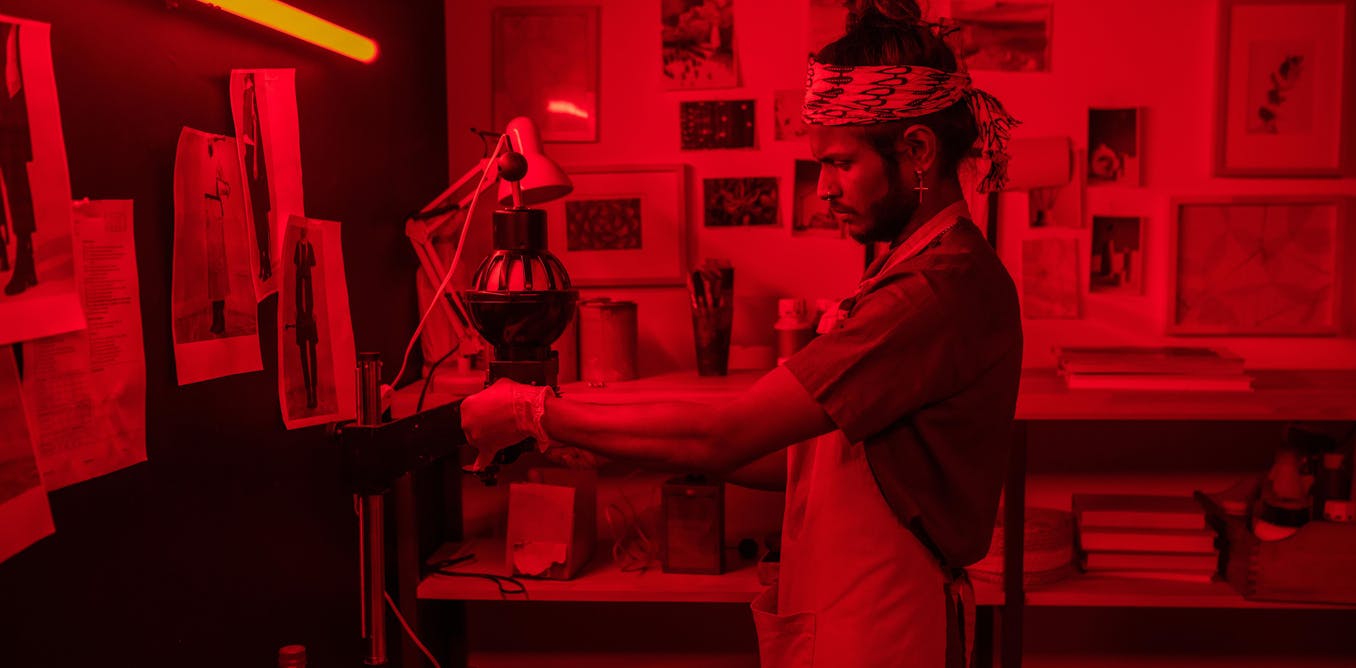Artists are generally thought of as either starving in a garret (La Bohème and all that) or jammy millionaires producing works valued at eye-watering sums (hello Damien Hirst). But the reality of life in the visual arts is more prosaic and a great deal more worrying, as the publication of Glasgow University’s report into the pressures facing UK visual artists reveals.
The median annual income for self-employed visual artists currently stands at just £12,500, 40% less in real terms than they were earning in 2010. More than half of visual artists take on additional jobs, 51% of which are in non-creative fields.
But even with additional jobs, the median individual earnings for visual artists remains at an unsustainable £17,500. And if you wonder how artists manage to live on such low income, consider that women in the visual arts typically earn 40% less than men.
This article is part of our State of the Arts series. These articles tackle the challenges of the arts and heritage industry – and celebrate the wins, too.
Those earnings are “unstable” or “very unstable” for 81%, making the working lives of artists, photographers and illustrators volatile and precarious. As freelancers, visual artists are excluded from the protections and benefits afforded to salaried employees.
Few have agents or representatives who might increase their negotiating clout. Many work speculatively, for no pay whatsoever in the hope that their output will eventually garner enough attention to usher them into a more professionalised – and remunerated – career.
The arrival of artificial intelligence (AI) has exacerbated the artist’s dilemma. While their work is being scraped to train AI, typically the rights holders themselves receive neither compensation nor credit for enabling this new technology.
Consequently, much of the freelance work that has typically supported artists, particularly in the crucial first five years after leaving education, has started to disappear.
Online publishers no longer need to commission or license images or photographs when an AI image generator will provide one ostensibly “for free”. Like all technology, AI presents both creative opportunity – a new tool which many artists are keen to experiment with – and destructive potential, where lookalikes of their work are easily accessible and undermine their own market.

Roger Bamber / Alamy
Not surprisingly, many young people look on aghast at the sheer difficulty of an artist’s life and are persuaded that it’s all too risky. Nationally, funding for the arts has been reduced by 33% in Scotland, 36% in Wales and 50% in England in real terms.
For local authorities, who bear much of the financial costs of the arts, austerity has been brutal, with cuts equivalent to 23% per person. Councils including Bury, Bolton and Tower Hamlets have had to sell art in their collection simply to stay afloat, and 467 museums have been lost since 2000.
But the issues impacting the arts can be hard to spot. Visit London’s West End and it looks vibrant enough, the museums heaving with tourists, the blockbuster shows selling out. But these institutions draw from curatorial and artistic talent that was inspired, developed and trained 20 to 50 years ago.
The schools that brought young people into the arts, as practitioners and consumers, are now significantly weakened or simply gone. The ecosystem from which the dynamism of then UK’s visual life drew its vitality, is now frail, expending dwindling resources to look like it is still alive. But it is becoming increasingly difficult to see where the next generation will stem from. Looking healthy is a far cry from being healthy.
A little optimism
But artists are resilient and the situation in the UK is not beyond remedy. The fundamental principles of copyright still apply, encoded in law, and royalties can still provide a vital lifeline for artists and generate re-investment for artists into their practice. But we’re lagging behind.
In many parts of the world, the degradation of artists’ rights through ubiquitous digital usage has been effectively addressed by the introduction of levies (a small percentage on each digital storage device sold) and has proved successful across the EU and in 45 countries in total, including Japan, Malawi, Canada, Morocco and Peru. What the University of Glasgow’s new research into the incomes of freelance visual artists demonstrates is that the time for the introduction of this mechanism into the UK is well overdue.
The proposed smart fund would both pay a return to artists for the use of their work on digital devices, and establish a fund to support creative initiatives around the country. This does not benefit artists alone; it boosts local economies. It also profoundly boosts national resilience.

Shine-a-Light / Alamy
The arts are not a discretionary nice-to-have luxury. They play a crucial role in the UK economy where income from the creative industries equals £126 billion, more than the pharmaceutical, aerospace and automotive industries combined.
That number underestimates the creative industries’ true impact as it doesn’t include things like tourism, which thrives when British film, art, sculpture, photography and design make people want to visit the country.
In this context, the unsustainability of an artist’s working life becomes, or should become, a matter of critical concern not to specialists but to the nation as a whole.
Precarious poverty need not and should not be the inevitable and defining characteristic of a freelance artist’s life. Copyright protection, a standardised approach to credit and attribution, together with the introduction of the smart fund could profoundly and swiftly rescue and revitalise one of the most dynamic sectors of the UK economy. The time is right now.

